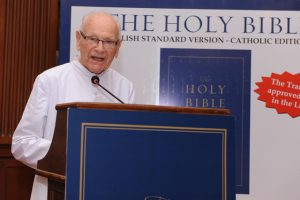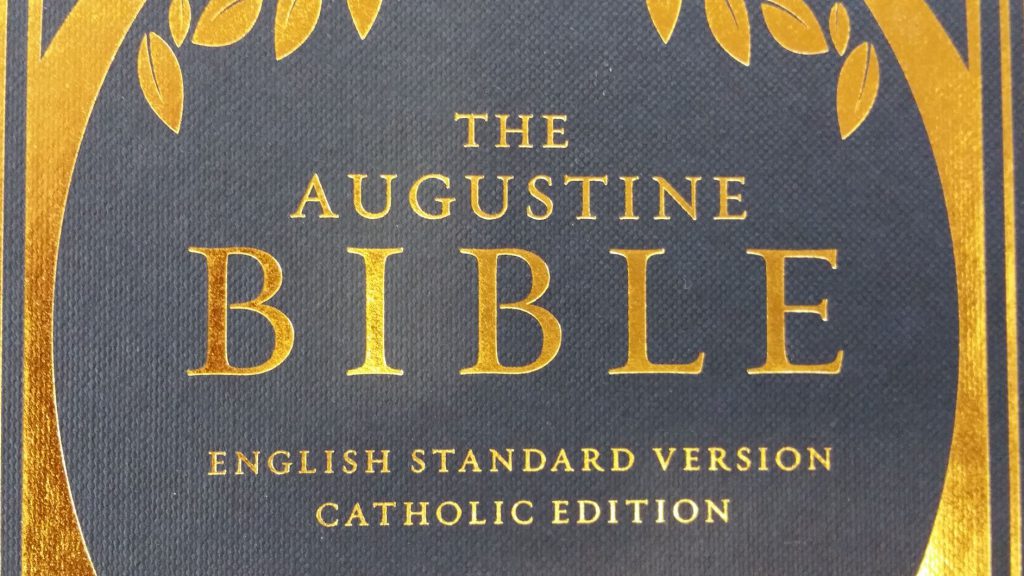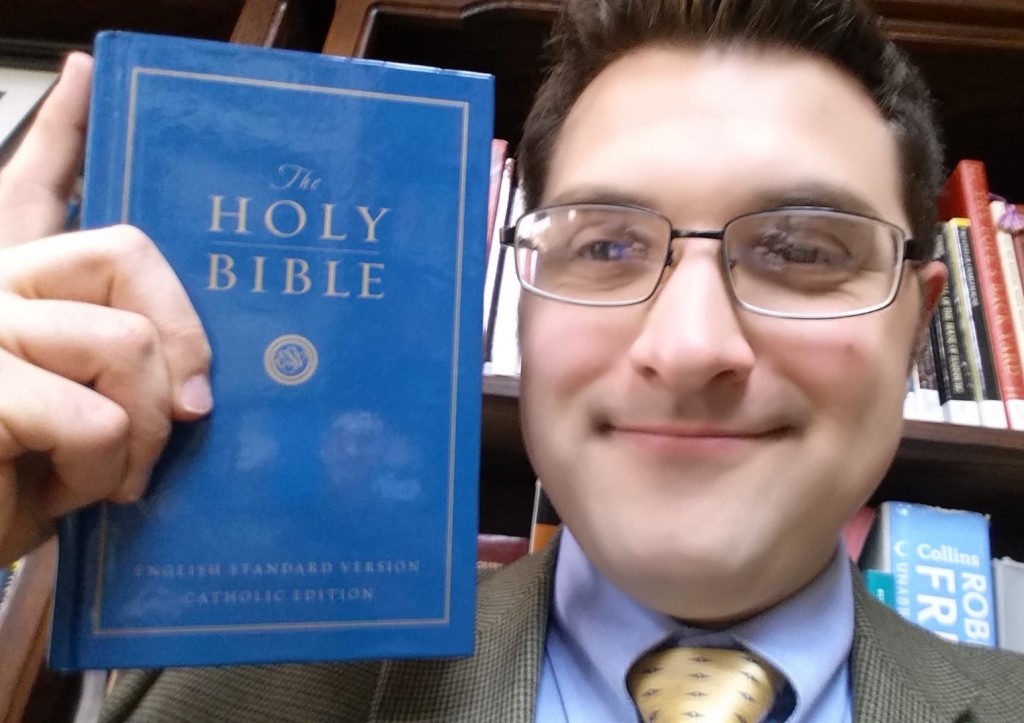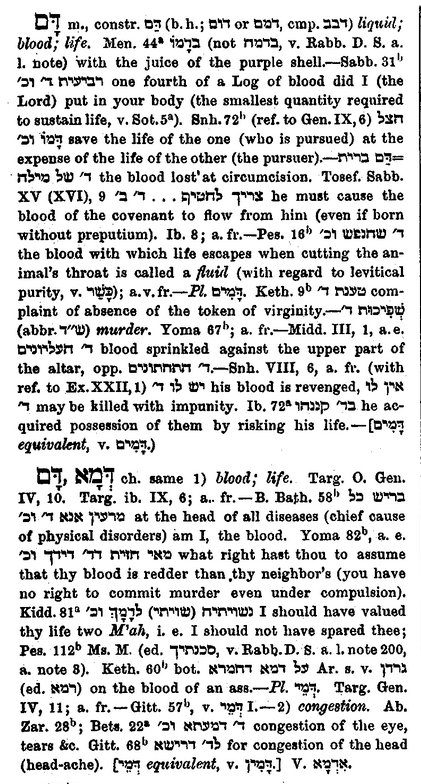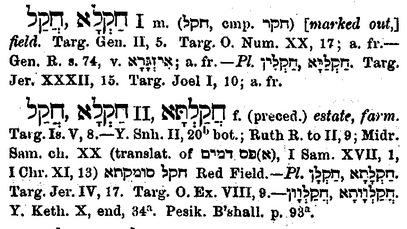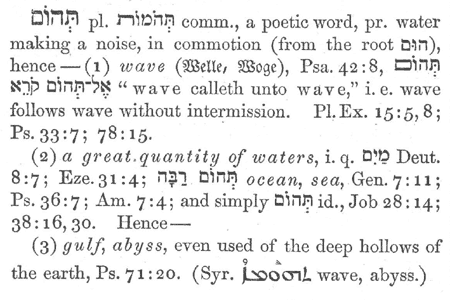I found this amazing clip today. It offers an inside-the-room, fly-on-the-wall view of a debate among the translators of the ESV. In this video, they debate how to render Hebrew and Greek words indicating “slave” or “servant.” In particular, it shows them voting to approve the change from “slave” to “bondservant” in certain NT passages. The video features Translation Oversight Committee members Paul House, Wayne Grudem, Gordon Wenham, Peter Williams and Jack Collins. It gives a sense of the serious nature of the translation debates and the types of evidence members would marshal to support their arguments:
Category Archives: Translation
Are Catholic Bible Translations Required to Work Directly From Biblical Languages?
In the promulgation of the new ESV-Catholic Edition, I’ve heard a lot of Internet chatter about various Bible versions in English. Many English-speakers have their favorite translation and will defend it to the hilt. I’d prefer everyone simply learn Greek and Hebrew, but since that’s not likely to happen anytime soon, we’re stuck with vernacular translations. Translation, by its nature, is an imperfect science.
Read the Bible
Ok, wait–before going any further, I’ll just say that I’d much prefer that everyone simply read the Bible a lot in whatever translation they find useful! So if you like the RSVCE, the RSV2CE, the NABRE, the ESVCE, the Douay-Rheims, the JB, the NJB, the RNJB or whatever, keep on reading the Word of God and don’t give up. This book will transform your life. Translation concerns are secondary to the actual practice of reading the Bible.
Back in Time
 It is too easy to over-simplify the history of the Bible in English with quick notes like, King James 1611 and Douay-Rheims 1610, but such notes are misleading. Bible translations are big, years-long processes involving lots of people and places. Over time, whether we like it or not, the editions actually printed vary and change whether deliberately or not. The Douay-Rheims Bible, lauded by some as the best Catholic translation, started with a New Testament in 1582, and then an Old Testament in 1610, but it was later substantially revised by Bishop Richard Challoner in the 1700’s. It was translated from the Latin Vulgate of St. Jerome in the Clementine edition. Unexpectedly, Bishop Challoner was often revising the text of the Bible in order to conform to the King James Version familiar to all English-speakers. An American bishop, Francis P. Kenrick, launched his own revision of the Douay-Rheims in the 1850’s and its New Testament was published in 1862 shortly before his death. The American bishops debated making this version the new standard, but eventually the idea was abandoned. (See Gerald P. Fogarty, S.J., American Catholic Biblical Scholarship [San Francisco: Harper & Row 1989] 14-34).
It is too easy to over-simplify the history of the Bible in English with quick notes like, King James 1611 and Douay-Rheims 1610, but such notes are misleading. Bible translations are big, years-long processes involving lots of people and places. Over time, whether we like it or not, the editions actually printed vary and change whether deliberately or not. The Douay-Rheims Bible, lauded by some as the best Catholic translation, started with a New Testament in 1582, and then an Old Testament in 1610, but it was later substantially revised by Bishop Richard Challoner in the 1700’s. It was translated from the Latin Vulgate of St. Jerome in the Clementine edition. Unexpectedly, Bishop Challoner was often revising the text of the Bible in order to conform to the King James Version familiar to all English-speakers. An American bishop, Francis P. Kenrick, launched his own revision of the Douay-Rheims in the 1850’s and its New Testament was published in 1862 shortly before his death. The American bishops debated making this version the new standard, but eventually the idea was abandoned. (See Gerald P. Fogarty, S.J., American Catholic Biblical Scholarship [San Francisco: Harper & Row 1989] 14-34).
The Origin of the Catholic Biblical Association
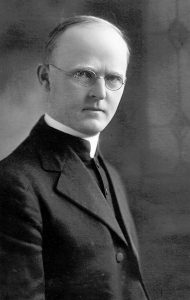 The need for a new Catholic Bible translation for the American Church was never abandoned. Indeed, it resurfaced in the 1930’s. Bishop Edwin Vincent O’Hara of Great Falls, MT organized an editorial board for a revision of the Challoner-Rheims edition, which invited all Catholic Scripture scholars to a meeting in New York for October 3, 1936 (Fogarty, 201). The meeting helped launch the Catholic Biblical Association, which produced a revision of the New Testament, published in 1941, the “Confraternity edition” (Fogarty, 206). Eventually, in light of Divino Afflante Spiritu and Dei Verbum, as I will explain below, the project of revising the Challoner-Rheims edition was abandoned and a completely new translation from the original languages was begun.
The need for a new Catholic Bible translation for the American Church was never abandoned. Indeed, it resurfaced in the 1930’s. Bishop Edwin Vincent O’Hara of Great Falls, MT organized an editorial board for a revision of the Challoner-Rheims edition, which invited all Catholic Scripture scholars to a meeting in New York for October 3, 1936 (Fogarty, 201). The meeting helped launch the Catholic Biblical Association, which produced a revision of the New Testament, published in 1941, the “Confraternity edition” (Fogarty, 206). Eventually, in light of Divino Afflante Spiritu and Dei Verbum, as I will explain below, the project of revising the Challoner-Rheims edition was abandoned and a completely new translation from the original languages was begun.
But what about the Vulgate?
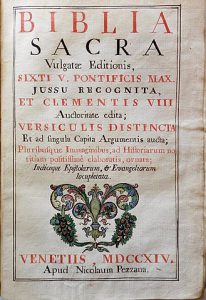 The Vulgate, the Latin translation of St. Jerome, was preserved and printed in many editions. It really became its own textual stream in the tradition of biblical manuscripts, but was somewhat codified by the Sixto-Clementine Edition of 1592. It’s important to note that this edition replaced the 1590 Vulgata Sixtina hastily prepared by Pope Sixtus V, who was apparently still making changes after it went to press with his approval in the bull Aeternus Ille. This edition was forcefully recalled by Pope Clement VIII early in his papacy and replaced by the new Sixto-Clementine edition. If you seek out a Vulgate today, I’d recommend checking out the critical edition from the United Bible Societies. The official Sixto-Clementine Vulgate has been replaced by the Nova Vulgata (1979), which “is the point of reference as regards the delineation of the canonical text” (Liturgiam authenticam, sec. 37).
The Vulgate, the Latin translation of St. Jerome, was preserved and printed in many editions. It really became its own textual stream in the tradition of biblical manuscripts, but was somewhat codified by the Sixto-Clementine Edition of 1592. It’s important to note that this edition replaced the 1590 Vulgata Sixtina hastily prepared by Pope Sixtus V, who was apparently still making changes after it went to press with his approval in the bull Aeternus Ille. This edition was forcefully recalled by Pope Clement VIII early in his papacy and replaced by the new Sixto-Clementine edition. If you seek out a Vulgate today, I’d recommend checking out the critical edition from the United Bible Societies. The official Sixto-Clementine Vulgate has been replaced by the Nova Vulgata (1979), which “is the point of reference as regards the delineation of the canonical text” (Liturgiam authenticam, sec. 37).
Translating to English from the Vulgate?
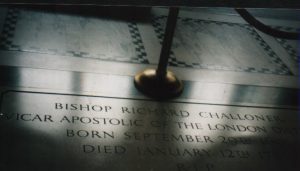 Most English-speaking Catholic authorities in the nineteenth century took it for granted that Catholic Bible translations into the vernacular be made from the Latin Vulgate. They were ignoring, perhaps, Bishop Challoner’s revisions of the Douay, which brought it more in line with the King James (translated from Greek and Hebrew). Even in 1859, a Catholic reviewer named Orestes Brownson would argue that “There is nothing in the decree of the Council of Trent, that requires our English translations to be made from the Vulgate…and a translation made directly from the original tongues into English will always be fresher, and represent the sense with its delicate shades, far better than a translation made from them through the Latin” (Brownson’s Quarterly Review; Fogarty, 22-23). While Brownson might have been prescient, he was ahead of his time.
Most English-speaking Catholic authorities in the nineteenth century took it for granted that Catholic Bible translations into the vernacular be made from the Latin Vulgate. They were ignoring, perhaps, Bishop Challoner’s revisions of the Douay, which brought it more in line with the King James (translated from Greek and Hebrew). Even in 1859, a Catholic reviewer named Orestes Brownson would argue that “There is nothing in the decree of the Council of Trent, that requires our English translations to be made from the Vulgate…and a translation made directly from the original tongues into English will always be fresher, and represent the sense with its delicate shades, far better than a translation made from them through the Latin” (Brownson’s Quarterly Review; Fogarty, 22-23). While Brownson might have been prescient, he was ahead of his time.
Later, in 1934, the Dutch bishops asked Rome about whether a translation from the original languages of Scripture, not the Vulgate, could be read in liturgy and the response from the Pontifical Biblical Commission (AAS 26, 1934, p. 315-warning! giant PDF!) was negative. Fogarty insists that this is “the first time” that the Vatican weighed in on the side of vernacular translations of the Vulgate over against translations from the original languages (p. 200). Whether he is right not, I’m not sure, but it would become a moot point in under ten years.
Pius XII and Original Languages — 1943-44
 In 1943, Pope Pius XII would publish the encyclical Divino Afflante Spiritu, (drafted by Augustine–later Cardinal–Bea) where he would encourage translations directly from the original languages with the following sentences:
In 1943, Pope Pius XII would publish the encyclical Divino Afflante Spiritu, (drafted by Augustine–later Cardinal–Bea) where he would encourage translations directly from the original languages with the following sentences:
22. Wherefore this authority of the Vulgate in matters of doctrine by no means prevents – nay rather today it almost demands – either the corroboration and confirmation of this same doctrine by the original texts or the having recourse on any and every occasion to the aid of these same texts, by which the correct meaning of the Sacred Letters is everywhere daily made more clear and evident. Nor is it forbidden by the decree of the Council of Trent to make translations into the vulgar tongue, even directly from the original texts themselves, for the use and benefit of the faithful and for the better understanding of the divine word, as We know to have been already done in a laudable manner in many countries with the approval of the Ecclesiastical authority.
Just before this encyclical was released, the Pontifical Biblical Commission issued a clarification of its 1934 response cited above. This clarification (AAS 35, 1943, pp. 270-71–warning! giant PDF!) explicitly granted permission for biblical translations from the original languages. Taking its cue from this clarification from the Biblical Commission and from the new encyclical, the Catholic Biblical Association decided at its meeting in August 1944 at Notre Dame to abandon the project of revising the Challoner-Rheims edition and instead launched a new project to translate the whole Old Testament from the original Hebrew and Greek. This project would eventually become the New American Bible.
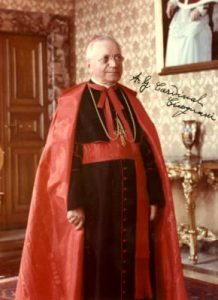 The CBA was additionally encouraged and congratulated on pursuing this project by the apostolic delegate, Archbishop Cicognani (his letter was published in Catholic Biblical Quarterly 6 [October, 1944] 389-90: https://www.jstor.org/stable/43723781). The Archbishop lauds the CBA for its efforts, acknowledging that the association is “translating the Old Testament from the original languages into English” and that “This news is a source of great pleasure, since the deep learning which forms the background of their work, and their well-known devotion to the Holy See are already in themselves auguries of success in the monumental work to which they have so resolutely set themselves.” Later in the letter, he nods in the direction of Rome, showing his interpretation of Divino: “Conformably to the recommendations of His Holiness, the members of the Catholic Biblical Association are laudably engaged in translating the Old Testament from the original languages for the use of the laity.” Here we see that the Roman trend in the direction of the original languages is affirmed and made more explicit by the Archbishop.
The CBA was additionally encouraged and congratulated on pursuing this project by the apostolic delegate, Archbishop Cicognani (his letter was published in Catholic Biblical Quarterly 6 [October, 1944] 389-90: https://www.jstor.org/stable/43723781). The Archbishop lauds the CBA for its efforts, acknowledging that the association is “translating the Old Testament from the original languages into English” and that “This news is a source of great pleasure, since the deep learning which forms the background of their work, and their well-known devotion to the Holy See are already in themselves auguries of success in the monumental work to which they have so resolutely set themselves.” Later in the letter, he nods in the direction of Rome, showing his interpretation of Divino: “Conformably to the recommendations of His Holiness, the members of the Catholic Biblical Association are laudably engaged in translating the Old Testament from the original languages for the use of the laity.” Here we see that the Roman trend in the direction of the original languages is affirmed and made more explicit by the Archbishop.
Consilium 1964
This direction was affirmed, albeit softly, by the Sacred Congregation of Rites in its document, Inter Oecumenici (Sept 26, 1964), 40.a:
The basis of the translations is the Latin liturgical text. The version of the biblical passages should conform to the same Latin liturgical text. This does not, however, take away the right to revise that version, should it seem advisable, on the basis of the original text or of some clearer version.
This slim legal language emphasizes the importance of the Vulgate, but defers to the original languages for revision.
Dei Verbum 1965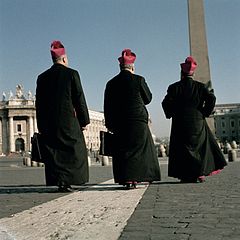
The Second Vatican Council weighed in on the side of translating Scripture from the original languages:
“the Church by her authority and with maternal concern sees to it that suitable and correct translations are made into different languages, especially from the original texts of the sacred books” (Dei Verbum, sec. 22)
This statement by the Council affirms that the hierarchy was moving away from Vulgate-only translations toward focus on the original languages.
Liturgiam authenticam 2001
Pope St. John Paul II’s document, Liturgiam authenticam, will actually cite the 1964 law in extending the legal requirement to mandate that all biblical translations be made from the original languages, not from other translations.
Furthermore, it is not permissible that the translations be produced from other translations already made into other languages; rather, the new translations must be made directly from the original texts, namely the Latin, as regards the texts of ecclesiastical composition, or the Hebrew, Aramaic, or Greek, as the case may be, as regards the texts of Sacred Scripture.
One might think that this instruction contradicts the very idea of JPII launching the Nova Vulgata in 1979, but the document anticipates such concerns, saying, “Furthermore, in the preparation of these translations for liturgical use, the Nova Vulgata Editio, promulgated by the Apostolic See, is normally to be consulted as an auxiliary tool, in a manner described elsewhere in this Instruction, in order to maintain the tradition of interpretation that is proper to the Latin Liturgy.” So the Nova Vulgata is normative for 1.) finding the canonical verses in the original language and for 2.) understanding the proper tradition of interpretation for the Latin Liturgy. However, it does not serve as the basis for the translations, but only as “an auxiliary tool.” Though it is true that Pope Francis issued a Motu proprio in 2017 which limits the application of Liturgiam authenticam, it seems to have little effect on the topic here.
Conclusions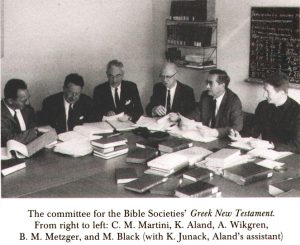
The complex task of Bible translation cannot be distilled down to any one principle. Indeed, any good translator should have respect for all of the available textual traditions, whether Hebrew, Greek, Latin, Syriac, or otherwise, and have a good sense for the strengths and weaknesses of each tradition. In previous eras, access to good instruction in the original languages was scare, but now much more common. Also, good manuscripts and critical editions were harder to come by, but now they can be readily had in libraries and on the Internet. Much of the text-critical work being done in older editions of the Vulgate has been transferred to the guild of text critical scholars of the Greek New Testament (one thinks immediately of the committee put together by Kurt Aland). The relative values of the Masoretic text and the Septuagint have not yet been fully ironed out and I imagine biblical scholars will be arguing about which should have priority until the sun sets on history. Yet from the above historical overview, we can see very clearly that the Catholic Church has been moving away from a Vulgate-only translation philosophy and toward a legal requirement that all biblical translations be made directly from the original languages. But again, whatever translation you are using: Read the Bible!
ESV Catholic Edition Bible Now Available in the United States!
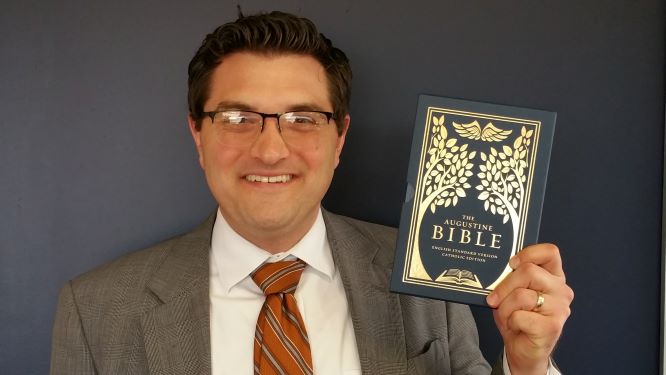 Last year, I wrote a post about the new English Standard Version Catholic Edition Bible (ESV-CE) published in India. This year, I have the great pleasure of announcing that this new translation is now available for purchase in the United States, thanks to the Augustine Institute! Yes, it is finally here.
Last year, I wrote a post about the new English Standard Version Catholic Edition Bible (ESV-CE) published in India. This year, I have the great pleasure of announcing that this new translation is now available for purchase in the United States, thanks to the Augustine Institute! Yes, it is finally here.
You can buy the ESV-CE Bible here: https://catholic.store/the-augustine-bible/
The Protestant Backstory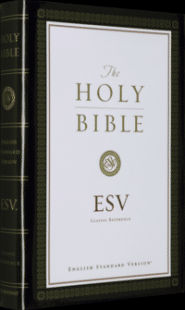
The ESV translation first came out in 2001 from Crossway publishers as a Protestant Bible for the Protestant market. The translation was partially born from a late-1990’s controversy over the inclusive language edition of the New International Version Bible–the NIVI. Many Bible readers were unhappy with the translation choices of the NRSV and NIVI. A new translation was needed. Instead of revising one of those translations, Crossway chose to go back to the RSV and then work from there.
What about the RSV?
The Revised Standard Vervsion (the Standard Version is the King James) originally came out in 1950’s and was revised in the 1970’s and then replaced by the NRSV. Many Catholic have used the RSV Bible in two versions–the original RSV-Catholic Edition and the so-called RSV-2CE from Ignatius Press, which was developed in partnership with the Congregation for Divine Worship under the guidelines of Liturgiam authenticam. The RSV-2CE is the translation in the Catholic Bible Study App offered by a partnership of Ignatius and the Augustine Institute.
What is different about the ESV?
The ESV is then a revision of the RSV. The ESV has modified about 60,000 words from the RSV. So it is a “daughter translation,” if you will, not a completely new from-scratch translation, but this makes the ESV feel like an old friend and a new teacher at the same time. It sounds strangely familiar and yet new. It offloads the archaic terms like the “thees, thous and wherefores.” It relies on better analyses of the manuscript tradition. The King James was based on the old Textus receptus of Erasmus, while the ESV is based on the newest critical editions available. It actually restores some King James readings that are more accurate than the RSV: “For example, Isaiah 7:14 was changed back to say, ‘Behold, the virgin shall conceive and bear a son.’ Psalm 2:12 once again says, ‘Kiss the Son,’ and Psalm 45:6 is once again a Messianic prediction that says, ‘Your throne, O God, is forever and ever'” (Source: Wayne Grudem, “The Advantages of the English Standard Version (ESV) Translation” p. 3).
How did a Protestant Translation become Catholic?
The Bishops Conference of India needed a new English translation for the Lectionary and other liturgical purposes. Crossway worked out a deal with them, where a team of Catholic theologians and Scripture scholars headed up by Fr. Lucien Legrand, M.E.P. (now 93 years old!), would review the ESV translation carefully and make some emendations. The Catholic team did indeed review–and change–the text of the ESV in preparation for publication. The biggest change was the Book of Tobit, which had to be retranslated from scratch. The translation was reviewed in accord with the norms of Liturgiam authenticam, then it was approved and granted the Impimatur by the whole Conference of Catholic Bishops of India and published in early 2018. It is available in India from the Asian Trading Corporation.
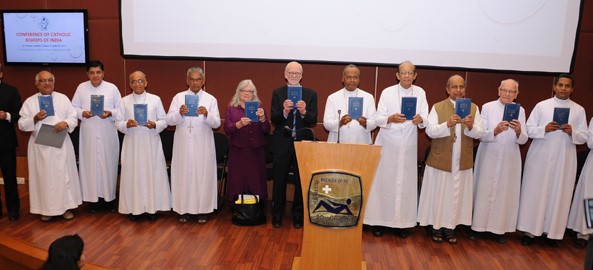
Indian Bishops with ESV (photo from daijiworld.com). Notice the founders of Crossway in the middle: Lane and Ebeth Dennis.
Speaking of Tobit, what about the deuterocanon?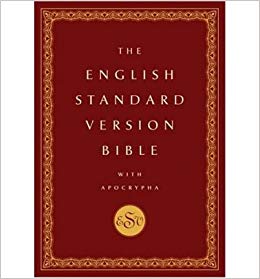
The original 2001 ESV did not include the deuterocanonical books (the ones in Catholic, but not Protestant Bibles), but in 2010, ESV did a joint publication with Oxford University Press which did include the deuterocanon. This edition, entitled “The English Standard Version Bible with Apocrypha,” was only published once as far as I can tell, but it served as the basis for the ESV Catholic Edition rendering of the deuterocanonical books, except Tobit, as I mentioned above.
Augustine Institute?
The Augustine Institute, where I teach as a professor of Sacred Scripture, though originally only a graduate school, has become something of a media and publication apostolate with our Formed.org video platform and our merger with Lighthouse Catholic Media. We struck up a conversation with Crossway about the ESV Catholic Edition a couple years ago. It became clear that Crossway, as a Protestant publisher, did not feel well-suited to serve the Catholic market and wanted a Catholic partner to promote the new translation. Earlier this year (2019), we reached an agreement and hurried to put out our first-ever Bible publication before the end of the year. (Well, our second if you count the “Bible in a Year” RSV-2CE to which I contributed.) We’ve dubbed it the “Augustine Bible” in honor of our patron.
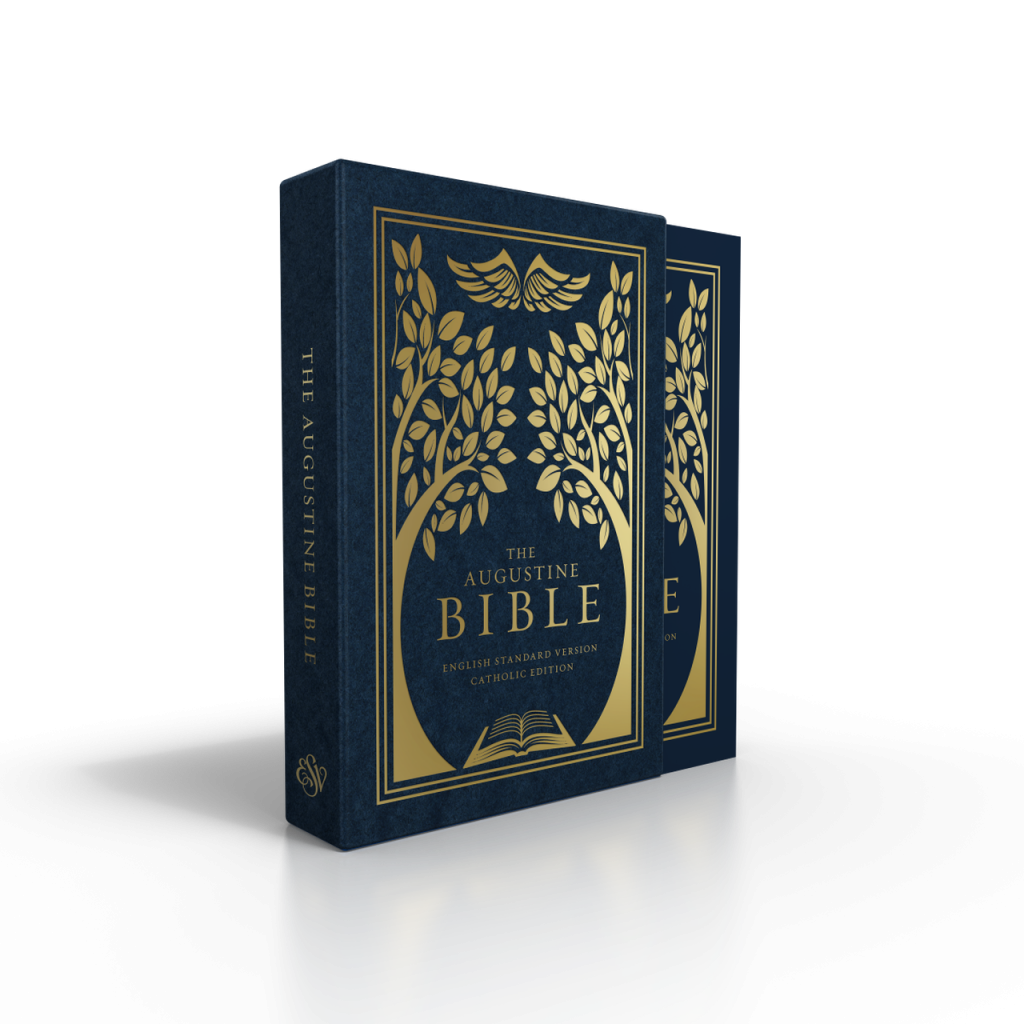 A New Beginning
A New Beginning
The first ESV Catholic Edition Bible available in the United States is now ready for order. It arrived in the Augustine Institute warehouse just a few days ago. This edition is really only the firstfruits of a huge new opportunity for Catholic Bible readers. Hopefully, the Augustine Institute will be releasing many different editions of this great translation over the coming years. I have enjoyed using the ESV for study and teaching for years and I hope that you enjoy the new ESV Catholic Edition as much as I have. So go ahead and order one and see what you think.
Here’s the link again: https://catholic.store/the-augustine-bible/
Review of ESV Catholic Edition Bible (ESVCE)
I got one! Yes, I think I might be the only Catholic in the United States to hold in my hands the new English Standard Version Catholic Edition Bible (ESVCE). Through my super-secret trading channels, I was able to secure one and now will offer a review and a backstory, just for you, my faithful reader. The Bible is printed on thin, high quality Bible paper in a very readable font. It feels just right in the hand—a bit smaller in form factor than your typical Bible with smallish print throughout. It contains a short Foreward, a Preface, a few grayscale maps and a chart of weights and measures. Thankfully, these materials explain the exact texts on which the translation was based.
Update 12/13/2019: ESV Catholic Edition Now Available in the United States!
A Breath of Fresh Air!
Finally, we Catholics get a new translation in clear English with serious attention to exact fidelity to the original text: the English Standard Version Catholic Edition, just released by the bishops of India. The same debate has been raging since the 1960’s in the English speaking world—on the relative merits of the New American Bible (1970), Revised Standard Version Catholic Edition (1966) and the Jerusalem Bible (1966). While we have received welcome updates on these translates like the NAB revised New Testament (1984), the New Jerusalem Bible (1985), the NRSV Catholic Edition (1991), RSV-Second Catholic Edition (2006), and the updated Old Testament in the NAB Revised Edition (2011—notice the 27-year delay between revised NT and OT), this ESVCE is a truly new Bible translation for us. Though it takes its cues from the 1971 RSV, the ESV stands on its own with its own translation philosophy and its strong commitment to clear and meaningful English that stays truly faithful to the original languages. (I’m not even including the simplified or quasi-paraphrase translations like the Good News Bible.)
Students, Bishops and the old Douay-Rheims
Catholic students of the Bible (who both read and write this blog!) have been arguing for years round and round about whether the RSV or NAB is better. Not only that but bishops’ conferences in the English-speaking world have been going round and round about which translation to use at Mass. The old Douay-Rheims translation (and its “Confraternity edition” followups) was discarded as antiquated after the Second Vatican Council. Besides, the old D-R was based on the Vulgate and did not take the Greek and Hebrew witnesses seriously. But after discarding the Douay, bishops were left with a problem on their hands. Fortunately, for American Catholics, the U.S. bishops had commissioned the Catholic Biblical Association of America to produce a new translation back in 1943, after the publication of Pope Pius XII’s encyclical, Divino Afflante Spiritu.
A Footnote from 1943
It’s an odd footnote to biblical history that the CBA had originally been commissioned to produce a new translation from the Latin Vulgate which was scrapped after Pope Pius XII encouraged recourse to the original languages (see paragraphs 14-16). The encyclical, which was drafted by biblical scholar Augustin Bea (later a cardinal), insisted that “we [ought] to explain the original text which, having been written by the inspired author himself, has more authority and greater weight than any even the very best translation, whether ancient or modern” (§16). This one line, along with the developing knowledge of biblical languages promoted by the Pontifical Biblical Institute, was instrumental in getting Catholics off the couch and into Greek and Hebrew courses. It sidelined Vulgate-only translations and insisted on fidelity to the original languages (Hebrew, Aramaic, Greek) in new translations.
Back to the Bishops
The bishops, since 1943 (and with renewed zeal after the Council), have been casting about for good Bible translations. Other language communities have perhaps done a better job cooperating, but the English-speaking world has been characterized by fierce competition. In particular, the United States Conference of Catholic Bishops actually owns the copyright to the New American Bible, so it is in their financial best interest to promote, and yes, to require, the use of the NAB/NABRE in liturgical settings. Though the USCCB does approve of other translations for non-liturgical use. The other English-speaking bishops (UK, Canada, Australia, New Zealand, India) have been none too thrilled about paying royalties to their brother prelates, so have normally opted for the Jerusalem Bible, but have also approved the New Jerusalem Bible, and the RSV. The Canadian bishops have adopted the NRSV as of 2008. The Antilles adopted the RSV-2CE for its lectionary. My sense is that many bishops’ conferences are none too thrilled with these options. The complaints, though often whispered, are easy to summarize:
- The Jerusalem Bible is too inexact, preferring dynamic equivalence over word-for-word translation. Same goes for its update, the NJB.
- The RSV is too old (from about 1950) with too many “thees” and “thous”.
- The NRSV has too much gender-inclusive language.
- Many complain about the NAB/RE, but frequently the complaints are directed at the New Testament footnotes in addition to the translation itself.
The ESVCE gives the bishops conferences a new option and indeed, several English-speaking bishops conferences have reached out to the Indian bishops to explore the possibility of using the new ESVCE lectionary in their countries.
ICEL, Liturgiam Authenticam, Vox Clara
To understand the backroom politicking at work, we must at least nod at some big decisions at the Vatican. After Vatican II, the English-speaking bishops set up the International Commission on English in the Liturgy (ICEL) to translate liturgical texts—including the Roman Missal, the Liturgy of the Hours, the Roman Martyrology and so forth. However, Bible translations, while often handled separately, had to be approved in the form of Lectionaries. In 2001, the Vatican issued a document entitled Liturgiam Authenticam which laid down rules for liturgical translations, which included Lectionaries. The Congregation for Divine Worship issued a new edition of the Latin missal in 2002,which served as the basis for the translation of the liturgy released in 2011. In order to implement Liturgiam Authenticam in the English-speaking world, the Vox Clara Commission was set up to oversee the work of ICEL (an angry history of it HERE). The Vox Clara Commission included some well known conservative churchmen (George, Pell, Olmstead). Notably, it also included Cardinal Oswald Gracias, who gave the imprimatur to the ESV-Catholic Edition and wrote the foreward. Recent news has seen Pope Francis moving to roll back a bit of the centralization of translation.
Back to Bible Students
Now, we Bible Students care little for the squabbles of high prelates: How faithful is the actual translation? Here’s where we get into the weeds to compare actual texts. I’m going to use the NABRE, the RSV-CE and the ESVCE to show you what we have on our hands. I’ll just present a bunch of examples without comment in no particular order. You can judge for yourself:
| NABRE | RSV-CE/2CE | ESVCE | |
| Prov 18:24 | There are friends who bring ruin, but there are true friends more loyal than a brother. | There are friends who pretend to be friends, but there is a friend who sticks closer than a brother. | A man of many companions may come to ruin, but there is a friend who sticks closer than a brother. |
| Luke 1:28 | And coming to her, he said, “Hail, favored one! The Lord is with you.” | And he came to her and said, “Hail, full of grace, the Lord is with you!” | And he came to her and said, “Greetings, O highly favored one, the Lord is with you!” |
| Eph 5:3 | Immorality or any impurity or greed must not even be mentioned among you, as is fitting among holy ones, | But fornication [2CE: immorality]and all impurity or covetousness must not even be named among you, as is fitting among saints. | But sexual immorality and all impurity or covetousness must not even be named among you, as is proper among saints. |
| Isa 9:6 | For a child is born to us, a son is given to us; upon his shoulder dominion rests. They name him Wonder-Counselor, God-Hero, Father-Forever, Prince of Peace. [v. 5] | For to us a child is born, to us a son is given; and the government will be upon his shoulder, and his name will be called “Wonderful Counselor, Mighty God, Everlasting Father, Prince of Peace.” | For to us a child is born, to us a son is given; and the government shall be upon his shoulder, and his name shall be called Wonderful Counselor, Mighty God, Everlasting Father, Prince of Peace. |
| Gen 1:1 | In the beginning, when God created… | In the beginning God created | In the beginning, God created |
| Gen 1:2 | and the earth was without form or shape, with darkness over the abyss and a mighty wind sweeping over the waters | The earth was without form and void, and darkness was upon the face of the deep; and the Spirit of God was moving over the face of the waters | The earth was without form and void, and darkness was over the face of the deep. And the Spirit of God was hovering over the face of the waters. |
| Mark 10:9 | Therefore what God has joined together, no human being must separate. | What therefore God has joined together, let not man put asunder. | What therefore God has joined together, let not man separate.
|
| Gen 18:11 | and Sarah had stopped having her menstrual periods | it had ceased to be with Sarah after the manner of women | The way of women had ceased to be with Sarah. |
| Matt 5:28 | But I say to you, everyone who looks at a woman with lust has already committed adultery with her in his heart. | But I say to you that every one who looks at a woman lustfully has already committed adultery with her in his heart. | But I say to you that everyone who looks at a woman with lustful intent has already committed adultery with her in his heart.
|
| Eph 5:19 | singing and playing to the Lord in your hearts, | singing and making melody to the Lord with all your heart | singing and making melody to the Lord with your heart,
|
| Rom 9:5 | …theirs the patriarchs, and from them, according to the flesh, is the Messiah. God who is over all be blessed forever. Amen. | …to them belong the patriarchs, and of their race, according to the flesh, is the Christ, who is God over all, be blessed for ever. Amen. | To them belong the patriarchs, and from their race, according to the flesh, is the Christ, who is God over all, blessed forever. Amen. |
| Jer 20:7 | You seduced me, LORD, and I let myself be seduced | O LORD, thou hast [2CE: you have] deceived me, and I was deceived; | O LORD, you have deceived me, and I was deceived; |
| Sir 22:3 | An undisciplined child is a disgrace to its father; if it be a daughter, she brings him to poverty. | It is a disgrace to be the father of an undisciplined son, and the birth of a daughter is a loss. | A father’s disgrace is in the birth of an undisciplined son, and the birth of a daughter is a loss. |
Obviously, I could go on listing examples forever, but here I will stop. The long and short of these examples is that the ESV preserves both accuracy and decorum with beautiful English in the King James tradition while updated with the most recent manuscript evidence.
Other Thoughts on the New ESV-Catholic Edition
It’s important to note that the ESV preserves the typical English verse numbering (along the lines of KJV, RSV, etc.) rather than reverting to the Hebrew numbering, which the NABRE tries to do. The Old Testament is translated from the Biblia Hebraica Stuttgartensia and the Göttingen Septuagint. The New Testament is translated from the Novum Testamentum Graecae, Nestle-Aland, 28th Edition. Tobit is a textual anomaly, so they used “the longer Greek text (Sinaiticus) supplemented by the shorter Greek text (Vaticanus) and the Old Latin version at points where the longer text lacks some verses” (p. xvi.).
Team of Catholic Scholars
The ESV Catholic Edition, while it comes from the translation done by American Protestants, was reviewed by a panel of Catholic scholars before receiving approval from the Indian bishops. The names of those scholars who reviewed the text are listed in the Foreward:
- Rev. Dr. Lucien Legrand, MEP
- Rev. Dr. Assisi Saldanha, CSsR
- Rev. Dr. Govindu Rayanna
- Rev. Dr. A. Alfred Joseph
- Rev. Dr. David Stanly Kumar
- Sr. Dr. Prema Vakayil, CSST
- Rev. Dr. Shabu Joseph Thottumkal, SDB
- Rev. Dr. Stanislas Savarimuthu
The publication was made possible by a licensing agreement between Crossway and the Asian Trading Corporation. You can try ordering a copy of the ESVCE at the ATC website, but I didn’t have much luck. It has received official approval and Imprimatur from the Catholic Bishops Conference of India.
Conclusions
Pretty soon, when you attend Mass in India, you will hear the ESVCE being read from the pulpit. I think it won’t be long before the ESVCE shows up in the hands of many Catholic Bible Students who are gathering in church basements, Catholic schools, Newman Centers and coffee shops for a good old-fashioned Bible study. The translation is solid, new and refreshing. I will be digging into it for more insights over time. The ESVCE could be a close competitor with the RSVCE/2CE. It’s hard to say which will win out or if they will live a peaceful coexistence. Bravo to the Indian bishop and to Crossway for gifting us with a powerful ecumenical collaboration that produced such a great translation. I think this new translation will be a blessing to many, many English-speaking Catholics. Once it is available for sale in the U.S. (or wherever you are), I recommend adding a copy to your Bible shelf!
New Catholic ESV (English Standard Version)
This is an exciting moment for me! Finally, at long last, a Catholic edition of the English Standard Version has been made available and received ecclesiastical approval in India.
The original ESV was published in 2001 as an alternative update to the RSV Bible, preserving the English Bible vocabulary inherited from the King James Version. The KJV was the original “Standard Version,” which was then updated by the “Revised Standard Version” and now the English Standard Version. It is a fascinating tale that the King James Version, which was published in a rivalry with Catholic scholars who put out the Douay-Rheims Bible about the same time, should now be brought into the Catholic realm. Of course, many Catholics use the RSV-Catholic Edition, but that translation was made around 1950 and does not take into account the last sixty-five years of scholarship. The RSV-CE has gone through updates like the NRSV-CE and the RSV-2CE, but the ESV represents a huge shift.
Now, it’s true that the ESV had translated the Deuterocanon–the books only in Catholic Bibles–but it had a relatively limited publication run under Oxford University Press. I snapped up a copy, but the text of these deuterocanonical books has not been widely available. I’ve been using the ESV regularly since 2005 and have really enjoyed the translation. It excels at literal word-for-word accuracy without becoming cumbrous and wooden like the NASB. Rather than revolutionizing biblical vocabulary (like the Jerusalem Bible, for example), it tries to preserve traditional and theological terms like “grace” and “righteousness”. These fidelities to the English Bible tradition make for a powerful read that connects “dots” in the mind more so than translation that try to be overly original. Yet the ESV was prepared by scholars who are up to date on the manuscript evidence and current exegetical debates. You can read the statement of their translation philosophy here: https://www.esv.org/translation/philosophy/
The Indian Bishops Conference plans to produce a new lectionary based on the ESV. In the interview video I’ve embedded above, they mention that they have heard interest expressed by bishops in England, New Zealand and Australia, who might opt to use the ESV-CE in their lectionaries. It would be very interesting indeed if the whole English-speaking world starts using the ESV-CE at Mass!
Soon, I think, the text of the ESV-CE will be available not only in India, but everywhere, including in the major Bible software programs like Logos/Verbum, Accordance and BibleWorks. If nothing else, it will be very nice for Catholics to have a new translation option for Bible reading and study. The publication is so new–just announced about ten days ago–that I can’t find a link yet to buy a copy, but I’ll post it here when I do find it. Happy Bible reading!
Here’s a link to an India news story about the release: http://www.daijiworld.com/news/newsDisplay.aspx?newsID=495081
Update: It looks like you can buy the ESV-CE from an India website, but I don’t know about shipping to the US or elsewhere: http://www.atcbooks.in/
Seasoned with Salt
I like to season my salads with salt, but the Bible has different ideas. I came across an odd connection here that I thought I’d share with you. St. Paul says:
Let your speech always be gracious, seasoned with salt, so that you may know how you ought to answer every one. (Col 4:6 RSV)
It is kind of a weird idea. I mean, how do you put salt on your speech? And if you could, what would that even mean? I know Jesus tells us “you are the salt of the earth” (Matt 5:13). He seems to mean that believers, disciples, make the world tasty to God. That is, the followers of Jesus enhance the world, make it better, spread the tastiness of the gospel and shed light through their preaching. Even then, he warns that salt can lose its flavor and be good for nothing (Mark 9:50||Luke 14:34). In both cases, Jesus and Paul, salt indicates the relation of the believer with the world–enhancing one’s conversation with the world or enhancing the world as a whole.
Yet the connection I found was more textual. Only one other place in the Bible does the phrase “seasoned with salt” appear. Here:
and make an incense blended as by the perfumer, seasoned with salt, pure and holy; (Exo 30:35 RSV)
It’s part of one of the few recipes in the Bible. This recipe is for the incense which will be used in the tabernacle and temple sanctuary. If Paul is alluding back to this Exodus recipe, what could he mean? Is he highlighting the sacred nature of Christian speech, that conversation with unbelievers takes on an almost prayerful/worshipful aspect, so much so as being similar to the holy incense offered in the temple?
 Some offerings are also seasoned with salt (Lev 2:13) and the Lord even makes a “covenant of salt” (Num 18:19), but I think the main thrust in Paul here links up nicely with Exodus 30:35. Strangely, the Hebrew alone preserves the idea that Paul references. The Hebrew has memulach, which is a pual participle meaning “seasoned with salt.” This is rendered in LXX as memigmenon, which simply means “mixed.” Paul’s phrasing in Colossians 4:6 is halati ertumenos, which clearly relies on the Hebrew, not the Greek. The participle here is from artuo, which means “to make salty” and halati means “with salt.” So we could translate Paul’s phrase as “to make salty with salt.” (One could easily think up some late nineties references here.)
Some offerings are also seasoned with salt (Lev 2:13) and the Lord even makes a “covenant of salt” (Num 18:19), but I think the main thrust in Paul here links up nicely with Exodus 30:35. Strangely, the Hebrew alone preserves the idea that Paul references. The Hebrew has memulach, which is a pual participle meaning “seasoned with salt.” This is rendered in LXX as memigmenon, which simply means “mixed.” Paul’s phrasing in Colossians 4:6 is halati ertumenos, which clearly relies on the Hebrew, not the Greek. The participle here is from artuo, which means “to make salty” and halati means “with salt.” So we could translate Paul’s phrase as “to make salty with salt.” (One could easily think up some late nineties references here.)
I think the point of Paul’s encouragement is relatively simple: that our spoken words be kind and Christlike, “in grace” and not in malice. The connection with incense highlights the holiness, purity and God-directedness of our speech, but the connection with Jesus’ salt sayings, like “have salt in yourselves” (Luke 14:34), emphasizes the good effects our salty words can have in the world around us.
What is the Catholic/Ecumenical “Message”?
I just received a copy of the new Catholic/Ecumenical Messsage Bible from the publisher. It came out in 2013, so I have no idea why they’re promoting it right now. This book includes Protestant seminary-professor-turned-pastor Eugene Peterson’s very loose translation of the Protestant canon and a new translation of the deuterocanon by the Catholic William Griffin.
The Message and Canon Law
I have to say the first thing that struck me was the blurbs on the back include two Catholic priests and an Episcopalian bishop. Notably absent was the endorsement of a Catholic bishop. That’s probably because under Canon Law Catholic Bibles are supposed to be approved by the national bishops’ conference. In the case of the U.S., that means the USCCB. The relevant canons are as follows:
Can. 825 §1. Books of the sacred scriptures cannot be published unless the Apostolic See or the conference of bishops has approved them. For the publication of their translations into the vernacular, it is also required that they be approved by the same authority and provided with necessary and sufficient annotations.
2. With the permission of the conference of bishops, Catholic members of the Christian faithful in collaboration with separated brothers and sisters can prepare and publish translations of the sacred scriptures provided with appropriate annotations.
These laws mean that a private Catholic individual is not supposed to publish his own translation of the Bible without appropriate ecclesiastical permission, even if that person is working on a Bible-publishing project in conjunction with Protestants.
When I asked the publisher of this Catholic/Ecumenical Message about this, I was told that they didn’t feel the need to request permission from the USCCB because the Message is a a “paraphrasal translation” only meant to supplement more formal translations. But in fact, Eugene Peterson is no slouch in biblical languages. He used to teach Greek and Hebrew and so the Message is not really a paraphrase at all, but a very, very loose (like spaghetti-noodle-knot-loose) translation of the original languages.
Canon law does not grant a dispensation, exception or legal loophole in the approval process to “informal” or “paraphrasal” translations of the Bible. Beyond that, since 1984, canon law has insisted that Catholic Bibles have “necessary and sufficient annotations.” That doesn’t mean that every Bible has to be a 3,000 page study Bible, but that Bibles do need to include some notes on the difficulties and obscurities in the text, particularly at places where people could easily get confused. The New American Bible, the Jerusalem Bible and even the RSV-CE provide these types of annotations.
Now, I’m no canon lawyer, but I must admit I do have misgivings about the publication of this “Catholic/Ecumenical Message” Bible without the approval of the bishops’ conference and with no imprimatur (The imprimatur indicates ecclesiastical approval for other religious books and is different from a bishops’ conference’s approval of a Bible translation).
The Message and Original Languages
While Eugene Peterson translated from the original languages, the Catholic scholar who translated the deuterocanon, William Griffin, chose a different tack. I’ll give it to you in his own words:
For my primary text, I could have used the Hebrew or, where necessary, the Greek manuscripts; but I didn’t. As I’ve already indicated, they seem to me to be the exclusive possession of the biblical scholars. Instead, I chose the Latin Vulgate—not the one put together by Jerome in the fourth century, but the revised and expanded edition called Nova Vulgata (New Vulgate) published in 1998.
Pope John Paul II wrote a brief preface to that translation in which he declared and proclaimed that the Nova Vulgata may be used as the authentic text when translating into English, especially in the Sacred Liturgy. And so that’s what I used.
Um, well, this is an interesting perspective, but I cannot agree with it. While Latin is the liturgical language of the Western Chruch, none of the Bible was written in Latin, so it’s a bit tendentious to suggest that it’s the best source for our vernacular translations.
Griffin refers to this little line in John Paul II’s Scripturarum Thesaurus (Apr 25, 1979):
This New Vulgate edition will also be of such a nature that vernacular translations, which are destined for liturgical and pastoral use, may be referred to it.
This line does not make the Nova Vulgata the base text for new Bible translations. It certainly does not override earlier magisterial statements about the importance of going back to the original languages. In fact, the Vatican has repeatedly encouraged the study of original languages and has often mandated that all vernacular translations of Scripture start with the Greek and Hebrew.
Pope Pius XII in Divino Afflante Spiritu (Sep 30, 1943) insisted on the primacy of the original languages:
…therefore ought we to explain the original text which, having been written by the inspired author himself, has more authority and greater weight than any even the very best translation, whether ancient or modern…
Pius XII is gentle in his mode of expression, but he’s basically saying that the original Greek and Hebrew texts of Scripture trump the Latin Vulgate (an “ancient translation”). His encyclical set off a tidal wave of new translations from the original languages.
Dei Verbum from Vatican II takes a similar line:
…the Church by her authority and with maternal concern sees to it that suitable and correct translations are made into different languages, especially from the original texts of the sacred books…
A pope and a Council both point to biblical translation from the original languages. Most Catholic Bibles now published all draw from Greek and Hebrew directly.
Late in the pontificate of John Paul II, a further instruction on translation for liturgical purposes was given. This document, Liturgiam authenticam (Mar 28, 2001), mandates:
Furthermore, it is not permissible that the translations be produced from other translations already made into other languages; rather, the new translations must be made directly from the original texts, namely the Latin, as regards the texts of ecclesiastical composition, or the Hebrew, Aramaic, or Greek, as the case may be, as regards the texts of Sacred Scripture.Furthermore, in the preparation of these translations for liturgical use, theNova Vulgata Editio, promulgated by the Apostolic See, is normally to be consulted as an auxiliary tool, in a manner described elsewhere in this Instruction, in order to maintain the tradition of interpretation that is proper to the Latin Liturgy.
In case there was any lack of clarity on this point, the Congregation for Divine Worship (Nov 5, 2001) issued a letter where they further clarified the mandate
Given the nature of certain statements that have entered the public domain through articles, internet postings and the like, the scope for misunderstanding of the Instruction on the basis of a superficial reading has unfortunately increased. Indeed, some even seem to have reached the erroneous conclusion that the Instruction insists on a translation of the Bible from the Latin Nova Vulgata rather than from the original biblical languages. Such an interpretation is contrary to the Instruction’s explicit wording in n. 24, according to which all texts for use in the Liturgy “must be made directly from the original texts, namely the Latin, as regards the texts of ecclesiastical composition, or the Hebrew, Aramaic, or Greek, as the case may be, as regards the texts of Sacred Scripture”. The Instruction in fact provides a clearer statement on the use of the original biblical texts as the basis for liturgical translation than the norms previously published in the Instruction Inter Oecumenici, n. 40a, published on 26 September 1964 (Acta Apostolicae Sedis 56 [1964] 885).
The point of piling up all these quotations is to say that the Catholic approach to Bible translation is to go back to Greek and Hebrew and then translate directly into the vernacular. The Nova Vulgata is helpful for indicating which books are to be included and which verses (where there are textual problems), it serves as the norm for traditional liturgical formulation, but it does not serve as the basis for new translations and it has not been commended to us as such by the magisterium. In fact, quite the opposite! Catholics should be reading Bibles translated from Greek and Hebrew.
The Message and Translation Philosophy
I readily admit that there are different legitimate translation philosophies and goals. They are usually put on a spectrum between the woodenly literal (like the NASB) and dynamic equivalence (Jerusalem). Usually in a separate category are the paraphrases like the Living Bible, which is truly a paraphrase of an English translation (the ASV). The Message tries to walk the line between paraphrase and dynamic equivalence. The point is to deliver to modern readers an intelligible, readable Bible that makes more sense than the supposedly clunky language of a typical Bible translation. Even Eugene Peterson did not want The Message to replace other translations or even to be read aloud in church services. He intended it as a study tool.
Just to give you a sense for how The Message upends traditional Catholic phrasing of biblical passages for a rather underwhelming “something else.” Take a look at the angel Gabriel’s greeting to theVirgin Mary:
The Message |
RSV (for comparison) – Luke 1:28 |
Good morning!You’re beautiful with God’s beauty,
|
Hail,full of grace,the Lord is with you! |
Need I say more?
The Catholic/Ecumenical Message does not carry ecclesiastical approval, translates the deuterocanonical books from a Latin translation and embraces a dubious translation philosophy. I’d spend your next Amazon gift card on something else.
Oh, and if you do need a very simplistic translation for a young person or someone who has trouble with English, take a look at the Good News Translation (also known as Today’s English Version) or the Contemporary English Version, both from the American Bible Society and both with ecclesiastical approval from the USCCB.
The Mysterious Disappearance of Wisdom 18:9b
I was studying this Sunday’s first reading, Wisdom 18:6-9 while working on my weekly column and noticed something rather odd: The second half of Wisdom 18:9 is simply missing from the text. The full verse in the NAB is:
For in secret the holy children of the good were offering sacrifice
and carried out with one mind the divine institution,
So that your holy ones should share alike the same blessings and dangers,
once they had sung the ancestral hymns of praise.
Yet the English Lectionary only includes:
For in secret the holy children of the good were offering sacrifice
and carried out with one mind the divine institution,
Now, often the Lectionary will include partial verses, but they are always indicated by a letter, so you might have Gen 18:1-10a, for example. But in this case, there is no letter indicated by the verse reference. I thought this mystery might call for a little Catholic Bible Student investigation, so I dug up a copy of the Ordo Lectionum Missio, editio typica altera from 1981. This is the official Latin listing of the Lectionary readings. And sure enough for Lectionary #117, Wisdom 18:6-9 are listed not 18:6-9a.

The abbreviation “Sap” is for “Sapientia,” Wisdom. After seeing this, I thought that the difference might be in the versification of the Nova Vulgata, on which the 1981 Lectionary is based. But no, the verse appears in full in the Nova Vulgata:
Absconse enim sacrificabant iusti pueri bonorum
et divinitatis legem in concordia disposuerunt;
similiter et bona et pericula recepturos sanctos
patrum iam ante decantantes laudes. (Wisdom 18:9)
You’ll also notice that the Ordo Lectionum also gives an “incipit” (Nox liberationis…) that clarifies the subject of the first line by adding a single word and omitting the first word of verse 6.
But in the end, we’re left with a puzzle. Why would Wisdom 18:9b be omitted from the reading in the English translation? Here are possible theories: (a) the Latin Lectionary actually omits the lines and the English translators followed suit, (b) the English translators made a mistake by omitting them, (c) the lines struck the English translators as problematic, so they deliberately omitted them. If we go with Theory C here, I still don’t understand why the lines would be problematic–perhaps because they mention the fact that the saints will share in dangers as well as good things?
Yet many other parts of Scripture talk about us sharing in suffering, so I can’t think that’s the issue here. In fact, the lines are included in the Spanish edition of this reading. I’d be curious to look at Lectionaries in other languages to see if these lines are present or omitted, but for now we’ll have to chalk this one up as a mystery!
Owl image credit: By Athene_noctua_(portrait).jpg: Trebol-a derivative work:Stemonitis (Athene_noctua_(portrait).jpg) [CC BY-SA 3.0 (http://creativecommons.org/licenses/by-sa/3.0)], via Wikimedia Commons
Akeldama – Aramaic in the New Testament (Post #6)
Over time, I’ve been doing a little series of posts on Aramaic in the New Testament. This is the sixth post.
This week, I came across an Aramaic term that I just couldn’t pass up. In Acts 1, we get a rather gruesome description of Judas’ suicide after his betrayal of Jesus. We’re told that the horrific hanging happened in a particular places called “Akeldama.” Here’s the passage:
18 (Now this man bought a field with the reward of his wickedness; and falling headlong he burst open in the middle and all his bowels gushed out.
19 And it became known to all the inhabitants of Jerusalem, so that the field was called in their language Akeldama, that is, Field of Blood.) (Act 1:18-19 RSV)
Note on the Location
You can go look up the location, but basically it was and is a field of red clay dirt that was used by artisans in antiquity as a natural resource for making clay pots. In Matthew 27, 7, 10, the place is referred to as the “Potter’s Field” (Greek: τὸν ἀγρὸν τοῦ κεραμέως), hence the notion that the clay dirt was used for making clay pots. When it is called “field of blood” in Acts 1, the origin of the term might not be Judas’ suicide, but rather the red color of the dirt. The other thing to say is that Matthew and Acts differ on who purchased the field. In Acts, Judas bought the field, but in Matthew 27:7, the priests who paid Judas to betray Jesus bought the field to bury him. Either way, the location is still around and orthodox Christians have built a monastery on the place creatively nicknamed “Aceldama Monastery.” The field has also been used as a burial place.
Note on the Aramaic Word “Akeldama”
Simply, the word Akeldama transliterates the Greek “Ἁκελδαμάχ” (transliterated more precisely, Hakeldamach, note the appropriate rough breathing) which transliterates a combination of two Aramaic words: חֲקָל דְּמָא (chaqal dema). Some Greek manuscripts have a better spelling: Ἁκελδαμά (Act 1:19). Oddly, the English eliminates the Greek rough breathing which aims to transliterate the consonant chet. The word, dema or dma, means “blood” and appears many times in various combinations in Aramaic texts, as listed in the online Comprehensive Aramaic Lexicon. Here is the entry from Jastrow’s dictionary:
So the word, dam or dema, normally means blood, but can also refer to other fluids. The other word is chaqal, which means field. Again, CAL has a great listing and here’s Jastrow:
The word “Akeldama” represents then, the construct chain חֲקָל דְּמָא (chaqal dema). In which the first word, chaqal is masculine singular construct and dema is masculine singular emphatic. The construct chain is definite since it is a proper noun–like “the king of Persia” in Ezra 4:24–hence “the Field of (the) Blood” is the best translation. Note that Luke refers to “their own dialect” (ta idia dialekto auton), which indicates both he and his intended reader, Theophilus, are not part of the group of native Aramaic speakers, but native Greek speakers.
Conclusion
I suppose there’s no rocket science involved in explaining Akeldama. I think the only thing to say is that the English could do a better job transliterating it – perhaps as Halkeldema. The word simply means what Luke says it means “field of blood.”
What is the Meaning of “Deep calls to Deep”?
Psalm 42:7 inspires the imagination, but do we actually get the translation right? Do we really understand what this verse means?
I’ll quote the King James here:
Deep calleth unto deep at the noise of thy waterspouts:
all thy waves and thy billows are gone over me.
Ok, so for an updated-sounding translation, here’s the ESV:
Deep calls to deep at the roar of your waterfalls;
all your breakers and your waves have gone over me.
Often, people use this verse to describe the nature of prayer–a “calling out” from deep within oneself to deep within God. You can get a sense for it from the songs which quote this verse like “Deep Calls to Deep” by Mary-Kathryn or Matt Redman’s song by the same name. You can get a sense for the Christian preaching inspired by this line from Benny Hinn talking about intimacy with God. There are many other sermons, homilies, songs and inspiring Christian reflections on this phrase. But, do we really get it right? I think not.
The typical interpretation in these Christian reflections tries to associate the phrase to a personal communication between God and the soul. However, I think our Psalmist is actually trying to poetically describe water. Yep, water. Notice the rest of the verse about waterfalls and waves. The phrase “tehom el-tehom qore“. The ever-helpful Blue Letter Bible gives us a dictionary entry on the significant word here, tehom “deep”:
Notice the relevant line: “‘wave calleth unto wave,’ i. e. wave follows wave without intermission.” The word tehom normally is referring to a big body of water like the sea. Here though, the psalmist is talking about moving water, wave after wave, or in the case of a waterfall, crash after crash of the water from above. “Deep calls to deep” describes as best as a poet can the awesome power, repeated crashing and visual impact of wave after wave, not the cry of the heart.
Now of course, this verse does come in the context of a poem about intimacy with God, which describes thirst for God, the joy of his presence and the terror of his loss. It deals with the depths of despair and conflict and the agony of tearful longing for God. But the personal dimension is at the end of this verse rather than the beginning. It says: “your breakers and your waves have gone over me.” The Psalmist feels overwhelmed by the darkness and despair he is experiencing, hitting him with wave after wave. He is mourning and oppressed (v. 9). He seeks hope, but finds taunting. His prayer is to be released from the overwhelming waters of darkness into intimate union with God. So, yes, this Psalm is about intimacy with God, but somehow we have a hard time getting the details right.

